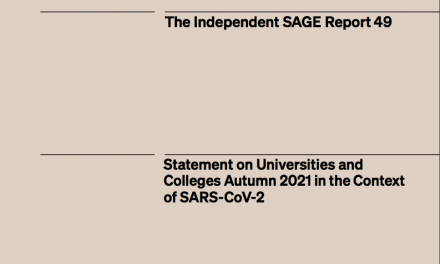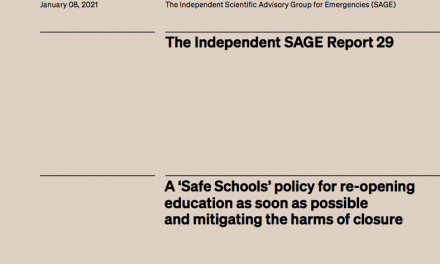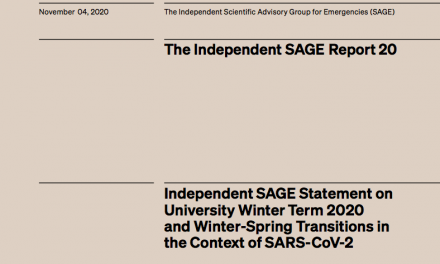Should Schools Reopen?
This report is the Independent SAGE’s interim findings and concerns – a draft document for public discussion. Please read the report here.
+++
UK Cabinet Office Minister Michael Gove has re-asserted the Government’s position that state schools should reopen from 1 June if certain conditions are met. But this has provoked a mixed response with considerable questions being raised by parents, headteachers, teaching unions, local authorities and health professionals. Many Local Authorities have come forward saying they are not ready, and the British Medical Association and teachers’ unions are urging caution.
While there is no dispute that schools play a fundamental role in the development of children’s emotional, social and intellectual development, it is also important to remember that schools are embedded within communities. The issue of schools reopening during COVID-19 does not just have implications for pupils; it also has knock-on effects for adult staff, parents and the communities and locality from which pupils come from.
That said we recognise the issues facing decision-makers are complex, with the task of balancing numerous, different and sometimes conflicting needs of children, parents, and teaching and school support staff. We understand that there is an imperative for children to return to school for their own wellbeing, and that this will also enable some parents to return to work (others will clearly have to remain at home if there is no provision for the children to go to school), but it is also vital that an appropriate level of safety for children, staff and the wider community is ensured.
Using the frameworks of the recently published guidance from UNESCO (new guidelines to provide a road map for safe reopening of schools) and WHO guidance for schools, we have considered (and are continuing to consider) the impact of school opening on children, staff, and the wider community – including parents, grandparents and guardians. Schools do not operate in a social vacuum, and what happens in schools will have wide ramifications for everyone within and outside of schools. It is for this reason that our approach and analysis in this report about whether schools should reopen on 1 June 2020, has to a great extent been led by questions and concerns sent to us by parents, teachers, inspectors, health professionals and ordinary members of the public about the important issue of schools reopening in a few weeks.
We were taken aback by the level of knowledge and understanding among ordinary members of the public about the prevalence and transmission rates of COVID-19 in their local communities, and among children and adults, but at the same time it was apparent that the public did not feel that they had sufficient scientific, social, and educational information from the government about the impact of schools reopening on their children, teachers and the wider community.
Questions and concerns from the public varied from whether it was safe to re-open schools, what criteria needed to be in place for schools to reopen, whether schools reopening for some children would sufficiently address concerns about educational gaps and children’s welfare, and the implications of schools opening on local communities, extended families and vulnerable children and adults. We were particularly struck by fears about the impact of coronavirus on children and extended members of households among black and ethnic minority parents who were acutely aware of the disproportionate hospital illness and deaths with COVID-19 among particular BME communities.
Schools represent a major axis of local communities. In the same way that school closures were highly disruptive, then school opening, and the manner in which this is done, will also be disruptive. A staggered school opening based on year groups has major implications for childminders, parents and guardians who may have responsibilities for siblings of different ages. The risk of top down decision-making without community involvement will mean that the burden will fall on individuals to find a way to make this work. We strongly recommend that decisions on school opening be made at local level, involving all stakeholders, to ensure there is support available as schools progress to full function.
We make recommendations based on existing evidence and new modelling, recognising the lack of evidence for many issues, and in such cases identifying options which are likely to minimise risk. We are sharing this document for public consultation via an online meeting on Friday May 22 from 12.00 to 1.30pm.
Over the next week we will take on board further public concerns, consult with other experts on education and public health, and review any new evidence from other countries alongside latest data from the UK to update and refine the recommendations in this brief report.
Pleas read the report here.
+++
In addition, please read the Advisory Report to the above report here.
This consultative group was formed at the invitation of the Independent SAGE group. It is informed by:
- Professor Helen Gunter, University of Manchester
- Dr Pam Jarvis, Leeds Trinity University
- Professor Liz Todd, Newcastle University
- Dr Terry Wrigley, Manchester Metropolitan University
This note was requested in the context of ongoing disagreement between education unions and the UK government on the re-opening of schools in England. The Covid crisis presents acute and unprecedented difficulties for policy, as the first serious pandemic in our times affecting Western Europe, the speed of global spread, and key differences between this and other viral infections. The scientific knowledge remains unclear concerning transmission involving children. Meanwhile children need support psychologically and socially as well as educationally, and there is an obvious danger of increasing disadvantage.
This note attempts to summarise the issues, in the context of statistical data, available medical knowledge, educational research and school norms in England. It has some relevance to other parts of the UK, but it is useful to consider England separately, given different infection patterns and school characteristics.
What would need to happen to enable schools to re-open
1) There needs to be close cooperation between public authorities (not just central government) and schools. Local assessments need to be made with regard to infection levels and more vulnerable groups. The government must ensure that local authorities have appropriate supervisory powers over all the schools and nurseries in their area.
2) Schools and nurseries will either need to be sufficiently well staffed for small classes and groups, or pupils alternate between on-site attendance and home learning. It is likely that home learning will continue for some children in all age groups.
3) Careful thought needs to be given to the main purpose of re-opening. The needs of the child should be at the centre of concern. This could mean, for example, that physical activity, exploring the natural environment, dance or drama has higher priority than academic learning. The facility for children to play and learn with a small group of friends may outweigh the desirability of strict physical distancing.
4) Similarly, when engaged in academic learning, it will be crucial to engage children’s interest and avoid undue pressures. National testing should be halted to prevent that pressure filtering down to individual teachers and their pupils.
5) In secondary schools, different curricular arrangements may be needed to keep children within the same group of 10-15 throughout the week rather than shuffling between multiple teachers and classes. For example, a week’s curriculum (perhaps mornings only) could be focused on a single major subject or an interdisciplinary project, complemented by distance learning provided by other subject specialists.
6) The quality of home learning support, including ICT, needs substantial improvement. There should be less reliance on commercial provision which is sometimes of poor quality.
7) Deliberate measures should be taken to overcome disadvantage. The foundation is to improve the amount and reliability of family benefits, including food, and to remove financial pressures affecting many families. Secondly, all children must have good access to technology: the government should ensure that every child has access to a laptop/tablet and free broadband. Thirdly, children in need of tutorial support should receive that help. Additional advice and support should be given to parents. Where not all pupils can attend full time, priority offers should be made to more disadvantaged families.
8) Apart from families who can afford holiday schemes and longer holidays away, there is very little provision for children during the long summer holidays in many parts of England. Priority should be given to planning holiday schemes which combine recreational activity with interesting academic learning, particularly in disadvantaged areas. This could be of far greater benefit than bringing all children back to school during July. The Best Summer Ever funding should be increased this year and extended to make sure national coverage. Children should be given free school meals during the summer and it should be delivered in cash rather than vouchers.
9) Careful planning is needed to trace and prevent transmission, using a variety of interventions and intelligent contact tracing. We cannot assume, for example, that children should be expected to undergo painful testing with nasal swabs. Before children are re-admitted to a school, risk assessment must include various kinds of vulnerability among families of pupils and staff.
Please read the full Advisory Report to the above report here.




